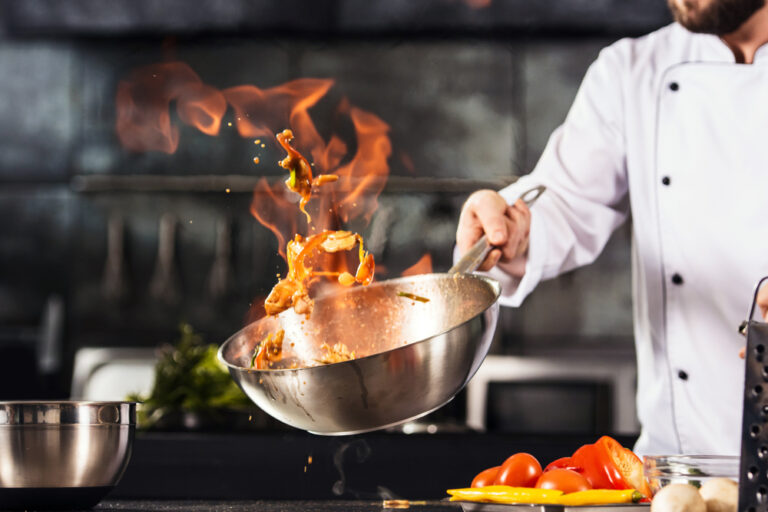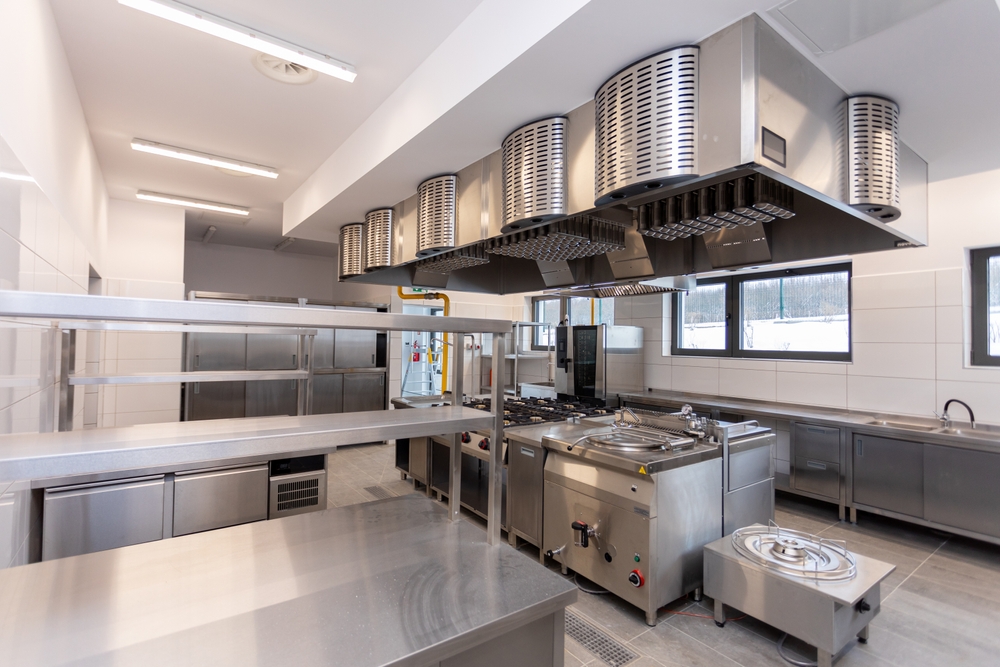A well-designed restaurant kitchen layout is more than just a bunch of appliances; it’s a carefully built ecosystem that keeps everything running smoothly. The way a restaurant kitchen is laid out, including the arrangement of cooking stations, equipment, and storage, can make or break the flow of your service and negatively impact your business.
Get it right, and everything will run more smoothly: food moves quickly, staff stay efficient and safe while the quality remains high. Get it wrong, and you’re looking at cluttered workspaces, higher risks of accidents, wasted ingredients, and lost revenue.
In this blog, we will examine the five essential zones that every restaurant kitchen layout plan should incorporate for maximum efficiency:
- The Preparation Zone
- The Cooking Zone
- The Plating and Service Zone
- Dishwashing and Cleaning Zone
- The Storage Zone.
Keep reading to understand how each of these zones plays a crucial part in keeping the operation clean, fast, and well-organised. Understanding how they work together can help reduce waste, avoid bottlenecks, and keep the team focused on what matters: preparing and serving great food.
Restaurant Kitchen Zoning for Efficiency
How should a commercial kitchen for a restaurant be laid out? It’s an important question to ask whether you’re starting from scratch or refurbishing an existing kitchen. When planning a restaurant kitchen, you should carefully think about the zoning layout. For more essential information and best practices about commercial kitchens, check out our FAQ on commercial kitchen design.
An efficient kitchen layout is characterised by a smooth, logical progression of food and staff movement, meticulously designed to minimise unnecessary travel and prevent operational bottlenecks.
Zone 1: The Preparation Zone
This is where the magic begins! Transforming raw ingredients into the building blocks of every dish. Organisation, efficiency, and strict hygiene protocols are essential here.
Primary Functions and Typical Activities in the Preparation Zone
This food preparation area is primarily dedicated to the transformation of raw ingredients through activities such as washing, peeling, cutting, chopping, slicing, dicing, mixing, measuring, and marinating. It is also where pre-cooking tasks, including the precise portioning and organisation of ingredients, happen.
Essential Kitchen Equipment in the Preparation Zone
In this area, you’ll find the tools that chefs and cooking staff need to prepare their delicious dishes. This includes:
- A comprehensive set of sharp durable knives of various sizes for precise cutting
- Chopping boards
- Colour-coded cutting boards
- Slicers
- Food processors, blenders, and mixing bowls
- Graters and peelers
- Measuring tools
This area should include ample counter space, preferably made of stainless steel for durability, hygiene and easy cleanup.
Preparation Zone: Design Principles and Location For Maximum Efficiency
The preparation zone is optimally located between the storage and cooking zones. This strategic positioning streamlines the overall workflow, as ingredients flow smoothly from fridge to prep to pan. Place it near sinks and power outlets, and keep everything grouped into clear stations. Use shelves, built-in bins, and vertical space to stay organised.
When planning a kitchen layout, don’t forget about lighting. This is important too, as the kitchen staff need clear visibility when handling sharp knives and assembling dishes. For example, avoid placing spotlights directly over walkways, as this creates shadows where staff are working. Position them above work surfaces like counters instead.
2. The Cooking Zone
It’s the beating heart of the kitchen: a place where creativity meets the hustle and pressure of high-volume cooking. The heat is intense, the pace relentless, and everything about the space has to work hard. That means a design built not just for performance, but for safety too.

Primary Functions and Typical Activities
This zone is dedicated to the transformation of prepared ingredients into finished dishes through a diverse array of cooking methods, including baking, roasting, frying, grilling, sautéing, and steaming. It typically operates as the busiest station, where multiple dishes are cooked and assembled concurrently, often guided by digital kitchen display systems (KDS) to ensure efficient order fulfilment.
Essential Kitchen Equipment in the Cooking Zone
The cooking zone requires robust commercial-grade kitchen equipment, such as:
- Commercial ovens (convection, combi, pizza, conveyor)
- Gas and electric ranges offer speed and precision, and more even cooking, respectively and are often integrated with ovens beneath.
- Deep fryers, grills
- Warming trays/lamps
- Specialty cookers
- Cookware and utensils
Cooking Zone: Design Principles and Location For Maximum Efficiency
The design of the cooking zone has to strike a careful balance: speed and efficiency on one hand, smart heat control and safety on the other. Every piece of equipment, from stoves and ovens to grills and fryers, should be placed with intention. Grouping similar tools helps streamline a chef’s workflow, while thoughtful zoning, like keeping high-heat burners to one side and low-heat ones in the centre, helps manage temperature and pace during service.
The cooking area should be centrally located or directly adjacent to the preparation station to facilitate the easy transfer of ingredients from prep to cook. Just as important, it needs to be close to the plating and service area. The shorter the path from pan to plate, the faster the food gets to customers, fresh and at its best.
High-quality ventilation systems in the cooking zone, including range hoods and exhaust systems, are also important for the safety of staff and customers. They pull out heat, smoke, grease, and strong odours, keeping the air breathable and the workspace comfortable. They also help prevent grease buildup and reduce the risk of respiratory issues for staff, which in turn supports staff health and maintains productivity.
Finally, don’t underestimate the power of layout. An open setup or well-placed stations can make it easier for staff to communicate and move efficiently, turning the kitchen into a truly collaborative space.
Zone 3: The Plating and Service Zone
This zone represents the final internal touchpoint for food before it is presented to the customer. Its design and operation are critical for ensuring impeccable presentation, precise temperature control, and a seamless handover to front-of-house staff.
Primary Functions and Typical Activities
This is where dishes come together before reaching the customer. Here, plating happens with care and attention to detail, with each portion garnished and arranged for visual appeal and consistency. The plating zone is also where quality control comes into play. Every plate gets a last look to make sure it meets the kitchen’s standards.
This zone plays a vital role in expediting orders too, acting as the hand-off point between the kitchen and the front of house. Timing matters, and keeping dishes at the right temperature, hot meals hot, cold dishes cold, is essential to delivering the best experience once the plate hits the table.
Essential Kitchen Equipment in the Plating Zone
To keep things running smoothly, the plating and service zone needs to be equipped with the right tools for speed, precision, and consistency. First and foremost: clean, spacious counters. Chefs need plenty of room to line up multiple dishes and plate each one with the care it deserves.
Keeping food at the right temperature is also important, so warming trays, heat lamps, or hot holding boxes are a must. For cold components and garnishes, cold storage areas or wells are necessary. Everything necessary to finish the dishes to perfection should be close at hand to cut down on delays.
As time matters, in many modern kitchens, digital Kitchen Display Systems (KDS) have replaced paper tickets. These screens keep orders organised, help prioritise timing, and improve communication between kitchen staff and servers, keeping the whole operation sharp and service flowing.
Plating Zone: Design Principles and Location For Maximum Efficiency
The plating zone is the final checkpoint before food reaches the customer, so its design needs to support speed, precision, and clear communication. Placing it right next to the cooking zone ensures that dishes move quickly from the kitchen to the plate without losing temperature or timing. This zone should be positioned as close as possible to the dining area to cut down on travelling times.
A dedicated pass or window between the kitchen and front-of-house streamlines the hand-off, making it easy for servers to pick up orders and for chefs to signal when they’re ready. This setup also reduces miscommunication and keeps service flowing smoothly.
Cleanliness and organisation are non-negotiable in this zone. A tidy workspace supports high presentation standards and helps prevent cross-contamination. An open kitchen design can also be a smart choice, as it allows for better oversight of plating and encourages consistency across dishes.
Ultimately, this is the last stop before a meal hits the table. Any delay, mix-up, or sloppy plating here can undercut all the effort that went into prep and cooking. A well-designed plating area keeps everything sharp, ensuring customers get their meals looking and tasting exactly as intended.
Zone 4: The Dishwashing and Cleaning Zone
A common mistake in commercial kitchen layout planning is to underestimate the importance of the dishwashing and cleaning zone, the quiet powerhouse in any kitchen. It plays a critical role in guaranteeing food safety, preventing cross-contamination, and keeping service running smoothly with a steady flow of clean dishes and tools.
Often overlooked, this zone is responsible for the systematic collection, and sorting of used plates, utensils, and glasses after service. From there, items move into dishwashers or pot-washing sinks for thorough cleaning and sanitising, meeting the strict hygiene regulations required in a commercial kitchen.
After washing, everything is placed on drying racks or designated storage areas, ready to be cycled back into use. Waste disposal is also part of the flow, with systems in place to separate food scraps from recyclables, helping the kitchen manage its environmental impact more effectively.
Essential Kitchen Equipment in the Dishwashing and Cleaning Zone
To keep up with the pace of a busy kitchen, the dishwashing and cleaning zone needs equipment built for volume, speed, and hygiene.
Of course, at the centre of it all are commercial dishwashers, available in different setups like undercounter units for smaller operations, rack-style machines, or full conveyor systems for high-demand environments. These machines are designed to power through large quantities of dishware quickly and effectively.
A standard three-compartment sink setup, one for washing, one for rinsing, and one for sanitising, is often required, along with a separate handwashing sink to meet health codes and keep things hygienic. For better organisation and flow, consider dish tables with drainboards that provide landing space on both the dirty and clean sides.
Last but not least, garbage disposals make it easy to get rid of food scraps before washing begins, while heavy-duty trash bins, with tight-fitting lids and pest-resistant design, handle solid waste.
The Dishwashing and Cleaning Zone: Design Principles and Location For Maximum Efficiency
This area, often out of sight, is absolutely vital for a smooth-running kitchen. Its design has to prioritise hygiene, smart waste handling, and an easy workflow. It needs to be physically separate from where food is prepped and cooked. This prevents any nasty cross-contamination.
Inside the zone itself, there’s a clear path: dirty dishes always stay separate from the clean ones. Placing the dishwashing area close to where dirty dishes are returned cuts down on how far they have to travel, making everything more efficient.
Waste management is built-in, with bins placed strategically near prep areas and cleaning spots for easy disposal. However, you’ll also need a dedicated spot for food waste, kept well away from kitchen equipment.
As a rule of thumb, it’s often best to put the dishwashing station at the back of the kitchen, maybe even near an exit, to keep noise and steam from bothering the main cooking areas.
Zone 5: The Storage Zone
Last but not least, the storage zone is crucial for keeping ingredients top-notch, managing your stock efficiently, and making sure the rest of the kitchen runs like clockwork.
Here’s what happens in the storage zone:
- This is where deliveries arrive and get stocked into their designated spots.
- It’s also ground zero for inventory management, meaning daily checks, careful tracking of any food waste, and systematically handling everything from fresh produce to canned goods.
- Most importantly, this zone is about organising and preserving all ingredients: dry, refrigerated, and frozen, to keep them fresh, prevent spoilage, and ensure they’re safe to eat throughout their shelf life.
Essential Kitchen Equipment in the Storage Zone
To keep ingredients fresh, organised, and easy to access, the storage zone needs a well-rounded mix of storage solutions and equipment, each piece serving a specific role in maintaining quality and efficiency.
Cold storage is a top priority. This includes:
- Walk-in coolers for bulk items
- Reach-in refrigerators for daily essentials
- Under-counter units for quick access.
- Freezers follow a similar pattern, from large walk-ins to compact models.
For dry goods, sturdy shelving is a must, whether open racks, enclosed cabinets, or a mix of systems. Airtight containers keep prepped ingredients fresh, while clear-panel bins offer easy visibility.
In tighter spaces, like in galley layouts, efficiency is key. Worktop refrigerators or storage cabinets can double as prep surfaces and built-in storage, saving valuable room. This comprehensive equipment system supports speed, safety, and smart inventory control from the very beginning.
The Storage Zone: Design Principles and Location For Maximum Efficiency
The storage zone is a key player in maintaining food safety, keeping things organised, and ensuring staff can grab what they need without hassle. The first step to ensure this? Clear separation.
Dry goods, refrigerated and frozen foods, and non-food items like cleaning supplies should all have distinct areas. This prevents cross-contamination and helps maintain order.
Shelving should be well-labelled and laid out logically so staff can quickly find what they’re looking for. In tight spaces, vertical storage solutions, like stackable bins, open shelves, and pull-out drawers, can help maximise capacity without sacrificing accessibility.
Storage doesn’t operate in isolation, but it’s deeply connected to the entire supply chain and inventory process. That means delivery areas should be close to the storage zone, giving vendors easy access to drop off supplies. Ideally, cold storage is also positioned near prep areas, so perishable ingredients get where they need to go quickly, staying fresh and safe.
Efficient receiving matters, too. Every delivery should be inspected and logged into inventory right away. From there, consistent use of the “First In, First Out” (FIFO) or “First Expiring, First Out” (FEFO) method ensures older stock gets used before newer items, cutting down on spoilage and waste by keeping older items toward the front.
| Zone | Essential Equipment |
| Preparation | Knives, Cutting Boards (color-coded), Mixing Bowls, Food Processors, Measuring Tools, Peelers/Graters, Dedicated Sinks, Commercial Slicers, Vertical Storage Racks |
| Cooking | Commercial Ovens (Convection, Combi, Pizza, Conveyor), Ranges (Gas/Electric), Deep Fryers, Grills, Warming Trays/Heat Lamps, Specialty Cookers, Pots/Pans, Cooking Utensils |
| Plating | Ample Counter Space, Warming Trays/Heat Lamps, Cold Holding Units, Service Utensils, Kitchen Display Systems (KDS) |
| Dishwashing | Commercial Dishwashers, Multi-Compartment Sinks, Dishtables, Garbage Disposals, Waste Bins, Dish Racks, Booster Water Heaters, Glass Washers |
| Storage | Refrigerators (Walk-in, Reach-in, Under-counter), Freezers, Dry Storage Shelving (Vertical/Horizontal), Airtight Storage Containers, Specialized Racks (e.g., can rollers, wine racks), Commercial Scales |
The Blueprint for Success: Kitchen Zoning is Everything
Designing a commercial kitchen plan for a restaurant, whether small or large, is no small feat. A restaurant kitchen is a carefully engineered system. The layout of every zone, from prep space to storage and cooking equipment, plays a direct role in how efficiently the team works, the quality of the food, and how safe the environment is. Nail that blueprint, and you’re building the foundation for a kitchen that runs like clockwork.
Need help with your future restaurant kitchen layout plan? Get in touch today for expert advice.


